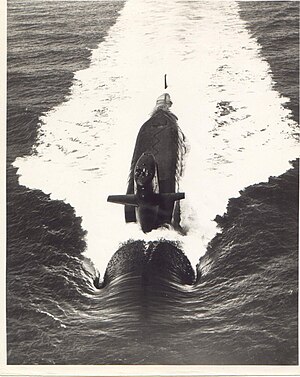USS Robert E. Lee
 USS Robert E. Lee (SSBN-601)
| |
| History | |
|---|---|
| Namesake | Robert E. Lee (1807-1870) |
| Ordered | 30 July 1958 |
| Builder | Newport News Shipbuilding & Dry Dock Company |
| Laid down | 25 August 1958 |
| Launched | 18 December 1959 |
| Sponsored by | Mrs. Hanson E. Ely, Jr |
| Commissioned | 15 September 1960 |
| Decommissioned | 1 December 1983 |
| Stricken | 30 April 1986 |
| Fate | Recycling via Ship-Submarine Recycling Program completed 30 September 1991 |
| General characteristics | |
| Class and type | George Washington-class submarine |
| Displacement | |
| Length | 381.6 ft (116.3 m)[1] |
| Beam | 33 ft (10 m) [1] |
| Draft | 29 ft (8.8 m)[1] |
| Propulsion | |
| Speed | |
| Range | unlimited except by food supplies |
| Test depth | 700 ft (210 m)[1] |
| Complement | Two crews (Blue/Gold) each consisting of 12 officers 100 enlisted |
| Armament | |
USS Robert E. Lee (SSBN-601), a George Washington-class fleet ballistic missile submarine, was the only ship of the United States Navy to be named for Robert E. Lee (1807–1870), the commanding general of the Confederate forces during the American Civil War.
Her keel was laid down on 25 August 1958 by the
Service history
Shakedown and training
The third
In January 1961, Robert E. Lee conducted additional simulated missile launches and on 15 January 1961 departed for the
Robert E. Lee conducted "special operations" out of Cape Canaveral during May and June 1961, and in late June departed for Holy Loch, Scotland, where she joined Submarine Squadron 14 on 10 July 1961.[citation needed]
Holy Loch deployment, 1961-1965
She conducted practice torpedo firing during the first week of August and departed Holy Loch on 9 August 1961 on her first deterrent patrol. During the next two years she completed nine more deterrent patrols.[citation needed]
On 10 September 1963, Robert E. Lee entered the floating drydock Los Alamos (AFDB-7), then on 4 October 1963 resumed her normal patrol schedule. Continuing to operate out of Holy Loch into 1964, she got underway on 27 November 1964 for her 16th patrol, which terminated on 28 January 1965 at Mare Island Naval Shipyard, Vallejo, California.[citation needed]
First refit, 1965
On 22 February 1965, Robert E. Lee entered the Mare Island Division of the
Emerging from overhaul after nearly a year and a half of work, Robert E. Lee got underway for
During the remainder of September and the first week of October, Robert E. Lee conducted
Holy Loch, 1967-1971
By 4 October 1967, Robert E. Lee had completed three more patrols. After drydocking in Los Alamos for minor repairs and hull surveillance, she resumed her patrol schedule on 1 November 1967 and completed her 21st patrol before entering drydock on 22 November 1967 for two weeks of repairs. She departed Holy Loch on 26 December 1967 for another patrol.[citation needed]
Robert E. Lee remained attached to Submarine Squadron 14 throughout 1969 and 1970. Continuing to operate out of Holy Loch, she completed her 33rd deterrent patrol on 1 January 1971.[citation needed]
Second refit (1971)
Robert E. Lee was drydocked for her second overhaul on 27 January 1971 at
United States East Coast operations, 1972-1973
In mid-August 1972, Robert E. Lee transited the Panama Canal and arrived in Charleston, South Carolina, on 14 September 1972. She continued normal operations, this time on the U.S. East Coast, throughout 1972 and for the first seven months of 1973.[citation needed]
Pacific operations, 1973-1977
Transiting the Panama Canal early in August 1973, she arrived in
Third refit, 1977-1978
In early 1977, Robert E. Lee drydocked for her third and final overhaul at Mare Island Naval Shipyard for nuclear reactor core refueling, equipment, and weapons upgrades. Sea Trials commenced in August 1978 and she went into operational status December, 1978.[citation needed]
Operations 1978-1983
The Gold Crew transited the Panama Canal January 1979. Transited to San Diego California, Bremerton, WA to Honolulu, HI. Turned over to the Blue Crew. In 1982-1983, Robert E. Lee's missiles were removed and she was redesignated SSN 601.[citation needed]
Decommissioning and disposal
Robert E. Lee was
References
External links
- https://www.ssbn601.org) New website 2022
- USS Robert E Lee official website
- This article incorporates text from the public domain Dictionary of American Naval Fighting Ships. The entry can be found here.
- Photo gallery of USS Robert E Lee at NavSource Naval History
